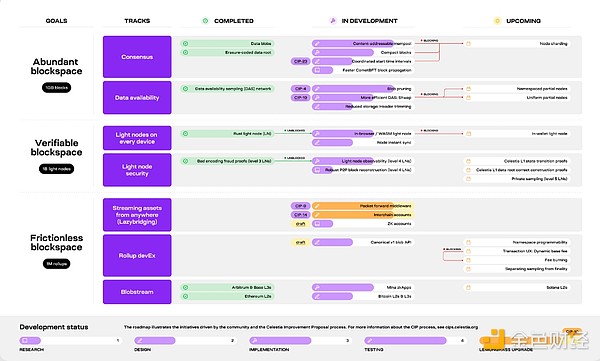Source: Celestia Foundation; Compiled by: Baishui, Golden Finance
After several years of development, Celestia Mainnet Beta went live last year. Since then, an early ecosystem has been formed, developers have deployed the first 20 rollups, and Celestia blobs account for 40% of the total data released.
As the early ecosystem develops, Celestia's core developer community has been working on the next phase of the protocol, with 16 public core developer calls and an active ZK working group with participants from many teams. The community has drafted or proposed 24 Celestia Improvement Proposals (CIPs) on behalf of six different core development entities.
Core developers are preparing for the first major upgrade, starting with Lemongrass, and have now proposed a technical roadmap contributed by multiple teams.
Scaling to 1 GB Blocks
The community’s roadmap has one core goal: to continually scale to 1 GB blocks, bringing a massive boost in data throughput to Celestia’s rollup ecosystem.
Before Celestia, scaling a permissionless blockchain typically meant optimizing the monolithic L1 in terms of consensus or execution of a single VM.
But Celestia is not limited by execution layer overhead or state bloat, which enables the roadmap to scale throughput beyond current monolithic constraints. And developers are not limited to a single smart contract language, virtual machine, or even rollup framework.
Instead, developers can build anything.
With Celestia, developers can deploy high-throughput, unstoppable applications using any VM, whether scaling existing ecosystems like Ethereum or as their own sovereign network.
The high-throughput DA already accelerates existing crypto applications, provides Web2-like latency to end users, and makes alt-VM L2 more performant than monolithic L1.
In previous eras, Visa’s transaction throughput (~24,000 TPS) was considered the ideal target for any scaling roadmap. The advent of a world-class computer was still a long way off.
With a relentless focus on DA, huge throughput gains can now be achieved simply by increasing the block size. Multiple technical innovations on the roadmap pave the way for 1 GB blocks, including content-addressable mempools, compact blocks, optimized CometBFT block propagation, internal shard nodes, and improved data availability sampling protocols.
With 1 GB blocks, Celestia will provide the capacity of multiple Visa networks simultaneously. This will unlock on-chain applications and functionality that were previously thought to be unfeasible, with enough throughput to support verifiable web applications and a fully on-chain world.
Anyone can verify from any device
Forcing users to rely on trusted black-box APIs defeats the purpose of crypto applications in the first place. The community is working to get light nodes running in web browsers so that anyone on any device can verify applications deployed in the Celestia blockspace.
Anyone can try an early version of a light node in the browser, built by Eiger on Lumina.rs.

The roadmap is built in line with this vision and is divided into three main workstreams:
1. Ample block space:The desire to achieve 1GB blocks ensures that Celestia has enough capacity to scale to a large number of different rollups, even for many Visa-scale payment networks, fully on-chain games, high-throughput DeFi and other high-throughput use cases. Unlocking true scalability and low transaction fees for end users. There are two core approaches to scaling DA throughput:
Consensus:Optimizing Celestia’s consensus network for maximum throughput, enabling larger blocks to be generated, giving users access to ample blockspace.
Data Availability:Improving Celestia’s data availability network to enable sampling and reconstruction of larger blocks while reducing resource requirements for various node types. This gives users the option of running a node on resource-starved devices or in a wallet on the backend.
2. Verifiable Blockspace:Ensuring that blockspace can be verified by anyone, anywhere, on any device, allowing users to directly verify the correctness of the blockspace protected by Celestia.
Light nodes on every device:Introducing light nodes to every device and end-user wallet. This enhances their security and reduces reliance on third-party committees or centralized infrastructure.
Light node security:Minimizes trust assumptions for end-users and node operators, providing them with higher security guarantees.
3. Barrier-free blockspace:Committed to removing any barriers for rollup developers and end-users. This goal is divided into three parts:
Streaming assets from anywhere (Lazybridging):Improve interoperability between rollups on Celestia and the base layer itself, solving the problem of modular fragmentation.
Rollup Developer Experience:Designed to enable the best developer experience for rollup developers.
Blobstream:Scale any ecosystem by streaming Celestia’s data proofs to another L1.
Explore the Roadmap Now
To help you understand the technical features and initiatives mentioned in the roadmap, we have compiled a comprehensive table. Click here to explore.
Community and Governance
The Celestia community drives all updates and initiatives through the Celestia Improvement Proposal (CIP) process. Learn more about the CIP process and currently ongoing CIPs here. This is an open process and discussions around it are public. Anyone in the community can voice their opinions and participate.
Get Involved
Stay tuned for more updates as the Celestia community continues to innovate. Join the discussion and contribute to the future of Celestia today!
 JinseFinance
JinseFinance
 JinseFinance
JinseFinance JinseFinance
JinseFinance JinseFinance
JinseFinance JinseFinance
JinseFinance JinseFinance
JinseFinance JinseFinance
JinseFinance JinseFinance
JinseFinance JinseFinance
JinseFinance JinseFinance
JinseFinance Alex
Alex